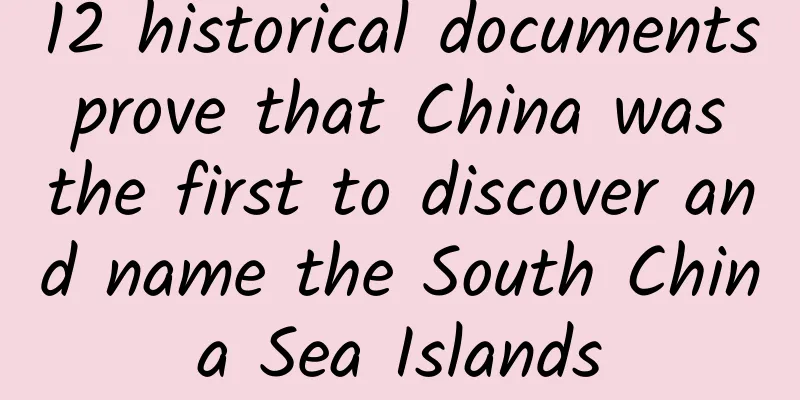12 historical documents prove that China was the first to discover and name the South China Sea Islands

|
As early as the Qin and Han dynasties more than 2,000 years ago, the Chinese people had already begun sailing and conducting production activities in the South China Sea. They were not only the first to discover the South China Sea islands, but also had a preliminary understanding of the South China Sea. During the Sui and Tang dynasties, the South my country Sea waters or islands and reefs were referred to as Qizhouyang, Shanhuzhou, Jiaoshishan, Xiangshi, etc. Although the names were different, they showed that as the Chinese people's activities in the South China Sea increased, their understanding of the South China Sea gradually deepened and became more specific. Natural scenery of South China Sea By the Song Dynasty, the South China Sea Islands and the South China Sea waters had become the home of the Chinese people's daily production and life. Not only were the different islands and reefs and different waters in the South China Sea clearly distinguished and named "Shitang" and "Changsha", but the South China Sea Islands were also included in the territory. The Chinese government's jurisdiction over the South China Sea Islands began to gradually expand from the Tang and Song Dynasties. During the Ming and Qing Dynasties, the mechanism for the Chinese government to implement jurisdiction over the South China Sea Islands became more complete. On the one hand, the South China Sea Islands continued to be clearly included in the territory and placed under the jurisdiction of Wanzhou, Qiongzhou Prefecture, Guangdong Province. On the other hand, the navy patrols continued. The coastal scenery of Zhaoshu Island in Sansha at sunset (Photo source: Xinhuanet) (The above content is excerpted from the People's Daily on May 24, 2016, p. 3, "The historical fact that China owns the sovereignty over the South China Sea Islands is indisputable." The author Li Guoqiang is a researcher at the Institute of China Borderland Studies, Chinese Academy of Social Sciences) China South China Sea Net has sorted out some historical materials on China's earliest discovery and naming of the South China Sea islands, proving that the historical fact that China has sovereignty over the South China Sea islands is indisputable. Reprinted with permission from the South China Sea Network (www.thesouthchinasea.org.cn) "Records of Strange Things" by Yang Fu (Eastern Han Dynasty) The Records of Strange Things written by Yang Fu in the Eastern Han Dynasty (25-220 AD) recorded: "At the head of the Zhanghai Sea, the water is shallow and there are many magnets." "Zhanghai" is the ancient Chinese name for the South my country Sea, and "Qitou" is the ancient Chinese name for islands and reefs in the sea. "Records of Strange Things in Southern Province" Wan Zhen (Eastern Wu during the Three Kingdoms Period) During the Three Kingdoms period (220-280 AD), Wan Zhen, the governor of Danyang in Wu, recorded the South China Sea Islands in his book "Nanzhou Yiwuzhi". There are many lost passages from "Nanzhou Yiwuzhi" in the "Taiping Yulan" compiled during the Taipingxingguo period of the Song Dynasty (977-983 AD), one of which is: "Juzhi went to Youyou for 800 miles. There is a river mouth. It goes southwest and northeast. There is a very large Jitou, and it comes out of the rising sea. It is shallow in the middle and has many magnets." Among them, "rising sea" refers to the South China Sea, "Jitou" refers to the South China Sea islands and reefs, and "magnets" refers to shoals and reefs. "Wu Jing Zong Yao" by Zeng Gongliang (Northern Song Dynasty) With the development of navigation technology, ancient Chinese people had a better understanding of the South China Sea and the South China Sea Islands. Since the Song Dynasty (960-1279 AD), the South China Sea Islands have begun to have more clear names. During the reign of Emperor Renzong of the Song Dynasty, Zeng Gongliang, the attendant of Tianzhang Pavilion (the fourth rank), and Ding Du, the assistant minister of the Ministry of Works, presided over the compilation of the "Wujing Zongyao", in which it was written: "Guangzhou Nanhai County...its area is 40 miles southeast of the sea, 420 miles east of Huizhou, 240 miles west of Duanzhou, 750 miles south of Enzhou, 250 miles north of Shaozhou, and 400 miles from the southeast by sea to Tuen Mun Mountain. The water is shallow for 20 miles, and you can travel 50 miles a day, a total of 200 miles. From Tuen Mun Mountain, use the east wind to travel southwest, and you will reach Jiuru Luozhou in seven days, and Bu Lao Mountain (original note: on the border of Huanzhou) in another three days, and Lingshan East (original note: there is sweet water) in another three days to the south. The southwest of it is to Daqin, Foshizi, India and other countries, and the distance is uncountable." After investigation, "Jiuru Luozhou" is today's Xisha Islands. "Answer from the Mountains" by Zhou Qufei (Southern Song Dynasty) Zhou Qufei, who served as the magistrate of Guilin during the Chunxi period of Emperor Xiaozong of the Southern Song Dynasty (1174-1189 AD), referred to the South China Sea Islands as "Changsha" and "Shitang" in "Lingwai Daida". He wrote, "Southwest of the four counties of Hainan, there is a sea called Jiaozhi Ocean. There are three converging rivers in it, and the waves are gushing and split into three: one is the south flow, which is the passage to the seas of various foreign countries. One is the north flow, which is the sea of Guangdong, Fujian, Jiangsu and Zhejiang. One is the east flow, which enters the boundless, the so-called East Ocean. When ships from the south come and go, they must rush into the three rivers. If there is a breath of wind, they can be rescued. If they enter a dangerous place without wind, the boat cannot get out and will disintegrate in the three rivers. It is said that there are long sand and stone dams in the East Ocean for tens of thousands of miles, and the tailgate leaks and sinks into the nine underworld. In the past, there was a ship that was pulled by the strong west wind and reached the East China Sea. The sound of the tailgate was so loud that there was no ground. Suddenly, the strong east wind saved it." "Records of Foreign Countries" by Zhao Rushi (Song Dynasty) Zhao Rushi, the director of the Quanzhou Maritime Customs in the Southern Song Dynasty, wrote the book "Records of Foreign Countries" which not only recorded the locations of the Thousand Mile Changsha and the Wanli Stone Bed, but also described the dangers of the sea areas there: "Outside are the islands called Wuli and Sujilang. To the south is Champa, to the west is Zhenla, and to the east is the Thousand Mile Changsha and the Wanli Stone Bed. The vast expanse of waters is endless, with the sky and water being the same color. Ships travel back and forth with only the compass as a guide, and watch carefully day and night. A slight error can mean life or death." Song Huiyao (official edition) (Song Dynasty) The official Song Dynasty Huiyao refers to the South China Sea Islands as "Shitang" or "Wanli Shitang": "Those who want to reach China sail from their country, and arrive at Bosnia in five days, then go to Kunlun Ocean, pass Zhenla, and arrive at Binda Yelang in a few days, and arrive at Champa in a few days. After ten days of crossing the ocean, there is a Shitang in the southeast, named Wanli. The ocean is sometimes deep and sometimes shallow, with fast water and many reefs. Seven or eight out of ten boats capsize and drown. There are no mountains or shores. Only then can you reach Jiaozhi. It takes five days to reach Qinlianzhou, all with favorable winds." "A Brief Account of the Island Barbarians" by Wang Dayuan (Yuan Dynasty) "A Brief Account of the Islands and Barbarians" written by Wang Dayuan, a folk navigator and geographer in the Yuan Dynasty, describes the topography and landforms of the South China Sea islands, which are generally referred to as Shitang. "The bones of Shitang originated from Chaozhou. It is like a long snake, stretching across the sea and crossing the sea countries. It is said that Shitang is ten thousand miles long. According to me, it is more than ten thousand miles long! The ship passed through Daiyumen, hoisted four sails, rode the wind and waves, and flew on the sea. It may take a hundred days to reach the Western Ocean. If we count a hundred miles in a day and a night, ten thousand miles is not enough, so the source of its land veins can be clearly traced. One vein goes to Java, one vein goes to Borneo and Gulidimen, and one vein goes to Kunlun in the West. It is said that the overseas land is connected to the land veins of the Central Plains. Is this what Ziyang Zhuzi meant? Looking at the boundless ocean, Shitang is hidden in the middle. Who can tell it? Avoiding it is good, but encountering it is bad, so the lifeblood of the man is at stake. If the boatman is not smart, he will capsize and drown! Alas! Don't go to the proud place again, how can you take the wind and waves as a path!" "Qiongtai Zhi" Tang Zhou (Ming Dynasty) The "Qiongtai Zhi" compiled by Tang Zhou in the early 13th century records that "most of the barbarian countries are in the southwest sea, winding to the south of the cliff, including Zhan, La, Siam, Ci, Wa, Fo, and Ni. To the east of Qiong is the sea, Qianli Changsha and Wanli Shitang, which are the places where the land is not satisfied." Here, the South China Sea islands are referred to as "Qianli Changsha" and "Wanli Shitang" respectively. "Sea Language" by Huang Zhong (Ming Dynasty) The names of the South China Sea islands were further clarified in the Ming Dynasty. In the book "Sea Language" written by Huang Zhong, the right assistant minister of the Ministry of War during the Jiajing period (1507-1566 AD), it is recorded that "Wanli Shitang is located to the east of Wuzhu and Duzhu Oceans. It is dark and gloomy, unlike the human world. It produces many giant clams and many birds, such as ghost cars, nine-headed ones, and four-three-headed ones, scattered on the sea. The sound of mournful cries can be heard for miles. Even the foolish men and brave soldiers were all in a state of grief. The helmsman lost his balance and fell into the rocks by mistake, and hundreds of bodies were recorded as ghosts"; "Wanli Changsha is southeast of Wanli Shitang, which is the Liusha River of the Southwestern Yi. The Ruoshui River flows out to the south, and the wind and sand are howling. On a clear day, it looks like heavy snow. If a ship accidentally hits the edge of it, it will be stuck and cannot be untied. Fortunately, the southeast wind is strong to avoid drowning." Here, Wanli Shitang refers to the Xisha Islands, and Wanli Changsha refers to the Nansha Islands. The Remaining Records of the Sea Raft by Gu Ji (Ming Dynasty) In "Haicha Yulu" (1617 edition), written by Gu Jie, who once worked in Danzhou (now Danzhou City, Hainan Province), it is recorded that "Qianli Stone Wall is 700 miles away from the sea surface of Yazhou. It is said that this stone is eight or nine feet lower than the sea water. Ships must avoid it as they will be unable to escape once they fall into it. The Wanli Long Causeway is located to the south of it. The waves and currents are very fast. No boat has ever been able to escape when it is caught in the vortex." The Qianli Stone Wall here refers to the Xisha Islands, and the Wanli Long Causeway refers to the Nansha Islands. Records of Maritime Affairs by Chen Lunjiong (Qing Dynasty) In 1730 (the eighth year of Yongzheng's reign), Chen Lunjiong, then the general of Taiwan Town, referred to the South China Sea Islands as Nan'aoqi, Qizhouyang, Wanli Changsha and Qianli Shitang in "Records of Maritime Affairs". It records that "Nan'ao Qi is located in the southeast of Nan'ao. The island is small and flat, with four sides hanging feet, all of which are jagged rocks. There are aquatic plants on the bottom, more than ten feet long. There is a sandbar in the bay, which absorbs the currents from all sides and cannot be reached by boats; if it enters the slipway, it will be absorbed and cannot return. The water distance between Nan'ao and Luoxia is seven shifts, which was called Luoxia in ancient times. The floating sandbank in the north is about 200 miles long, and the water distance is more than three shifts. There are two mountains named Dongshi and Xiang at the far north, facing Taiwan Shamaqi. The ocean is four shifts wide, and the ocean is called Shamaqi Toumen. Qi is suspended in the sea, and the sandbank continues to the south to the Guangdong Sea, which is Wanli Changshatou. The ocean is separated from the south by a name called Changshamen. From the south, the sandbank grows again to Wanzhou in Qionghai, which is called Wanli Changsha. The south of the sandbank grows jagged rocks to the Qizhou Ocean, which is called Qianli Shitang." Genglubu Ming and Qing Dynasties After the middle of the Ming Dynasty, my country began to give specific names to the islands, reefs, and beaches of the South China Sea. The Genglu Book, which was formed during the Ming and Qing Dynasties, was a navigation guide for Chinese fishermen traveling between the coast of mainland China and the South China Sea islands. It has been circulated in various versions of handwritten copies and is still in use today. It records the life and production and development activities of the Chinese people on the South China Sea islands, and records the names given to the South China Sea islands by Chinese fishermen. Among them, more than 70 names were given to the islands and reefs of the Nansha Islands. These names were either named after the directions of the Chinese compass, such as Chouwei (Zhubi Reef), Dongtou Yixin (Pengbo Shoal); or named after dialects, such as Huoai Reef; or named after special products, such as Chigua Line (Chigua Reef), Mogua Line (Nanping Reef); or named after the shape of the islands and reefs, such as Daochuan (Xian'e Reef), Shuangdan (Xinyi Reef); or named after some kind of object, such as Guogaizhi (Anbo Shazhou), Chenggouzhi (Huaryang Reef); or named after waterways, such as Liumen (Liumen Reef), Wufeng (Wufang Reef), etc. |
<<: The psychology of playing dead
>>: Nitrite was detected in self-heating hot pot. Can we still eat it?
Recommend
Is the flood that Dayu controlled the same as the one in the Bible?
I wonder if you have noticed that both Eastern an...
How to start online channel delivery from scratch?
Nowadays, most online education industries use on...
There is no way to catch them all! Why are power plants so afraid of "jellyfish infestations"?
A bumper harvest of jellyfish brought an unexpect...
How much does it cost to join the Zibo Second-hand Car Mini Program?
Is it easy to join the Zibo Second-hand Car Mini ...
Baidu vocational education and training industry advertising promotion case
This article shares with you Baidu’s advertising ...
Xiaohongshu promotion strategy: Xiaohongshu live broadcast internal testing!
According to Xiaohongshu influencers, Xiaohongshu...
Poppy looks like a vegetable and you can't really tell them apart? Be careful not to break the law!
recently Public Security Bureau of Dangyang City,...
13,000-word complete guide to Tik Tok operations and promotion!
This sharing is mainly divided into 4 parts: 1) T...
How to save yourself when facing a fire?
I believe everyone has seen the news about a fire...
The confusion of Qudian: Is it inclusive finance, or usury that walks on the edge of morality?
On October 20, Qudian Group (QD.NYSE), which had ...
APP operation and promotion tips: 37 free online promotion channels
The following is a complete guide that will intro...
What impact will the closure of Neihan Duanzi have on information flow advertisers?
On April 10, according to the official WeChat pub...
Live broadcast room operation, process and framework!
In 2020, the popularity of Douyin live streaming ...
Moldy food cannot be eaten, so why can tofu with hair on it be eaten?
Mold varies greatly in appearance The appearance ...
Stop taking calcium tablets every day! Wrong calcium supplementation is secretly causing "stones" to grow in your blood vessels
Many people feel that they are getting older, so ...









